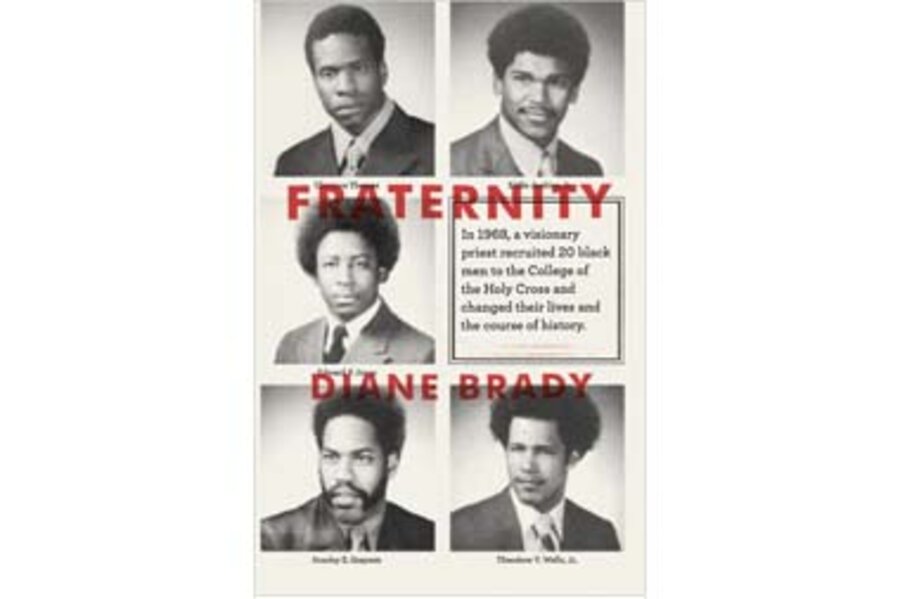Fraternity
Loading...
April 4, 1968: the day that Martin Luther King Jr. was assassinated. It was a time of sorrow and shame for many Americans, black and white. But for one idealistic Roman Catholic priest – shocked and grieved though he was – it become a moment of opportunity.
For months the Rev. John E. Brooks, dean of students at College of the Holy Cross in Worcester, Mass., had been lobbying his superiors at the Catholic men’s college to bring in more students of color. The one or two black students the school typically accepted each year were not enough, he said.
Administrators at Holy Cross didn’t necessarily disagree with Brooks. But at the time the school’s finances were weak and all were adamant that there was no money for minority scholarships – until the day of King’s assassination.
As the nation reeled and rioters looted, Brooks’s case instantly became more compelling. He was suddenly granted the right to recruit young black students and to offer them – on the spot, if he liked them enough – scholarships to attend Holy Cross.
Days later, Brooks was on the road, and he found 20 promising candidates, all of whom he managed to bring to Holy Cross to start school that fall. Among those men: Supreme Court Justice Clarence Thomas; Pulitzer Prize-winning novelist Edward P. Jones; NFL running back and politically active lawyer Eddie Jenkins; eminent Washington, D.C., trial lawyer Theodore Wells; and former deputy mayor of New York and investment banking executive Stanley Grayson.
“Was there something in the water?” journalist Diane Brady says she joked when someone introduced her to Grayson and he first told her about the remarkable men with whom he had enrolled at Holy Cross in the fall of 1968.
“It was Father Brooks,” Grayson told her.
And so Brady began following the story that she tells – with the cooperation of Thomas, Jones, Jenkins, Grayson, Wells, and others – in her book Fraternity.
It may be hard for some of today’s readers to understand the challenges these young men faced as they adjusted to life at Holy Cross. Most of them were from urban centers – Philadelphia, Washington, New York, and Detroit – and the quiet campus in Worcester seemed isolated and lacking in energy. Not all of their fellow students were welcoming and neither were some of the adults – including college alums and sometimes the parents of their roommates – with whom they came into contact. In addition, Holy Cross was an academically rigorous school, and not all had been sufficiently prepared by their high schools.
For some, the temptation to quit and go home was powerful.
But according to the men Brady interviewed, it was Brooks who made the difference. A man alternately described as generous and stubborn, warm-hearted and abrasive, Brooks took a deep interest in the young men, regularly seeking them out, offering them unqualified support, listening to their grievances, and intervening with the administration when he thought it was necessary.
“I wasn’t part of some program to Father Brooks,” Thomas would remember years later, “I was a kid.”
The experiment wasn’t always easy, either for the students or the school. But for the students who stuck it out (not all of the original 20 graduated), it was transformative, as it was for the school. Brooks went on to become president of Holy Cross for more than 20 years.
“Fraternity” is thorough and readable in chronicling the college experience of that first group of scholarship students. With its accounts of protests, walkouts, and building occupations, it also serves as a reminder of how tumultuous US college campuses were in the 1960s.
Perhaps most fascinating to some readers will be the glimpses the book offers into the character of Clarence Thomas. Thomas, who was interviewed for the book, emerges as a sensitive, conflicted young man whose worldview – including his aversion to affirmative action – was still in the process of being forged.
Several of the Holy Cross 20 have remained close to this day, and to many of them Brooks – who is now president emeritus and a humanities professor at the school – still serves as a friend and mentor. For his part, however, Brooks seems to claim little credit for the renown of the students he promoted.
Their success, he insists, is simply what a good education is supposed to produce.
Marjorie Kehe is the Monitor's Books editor.








